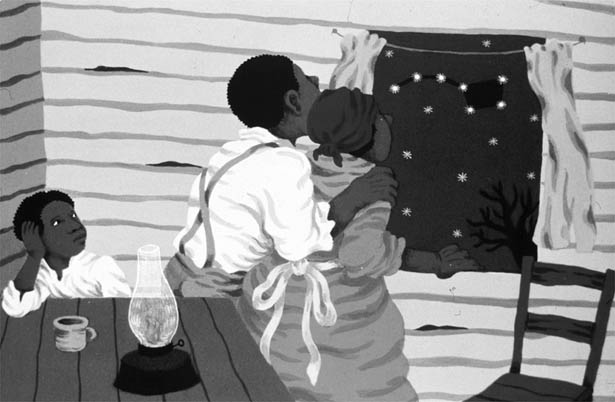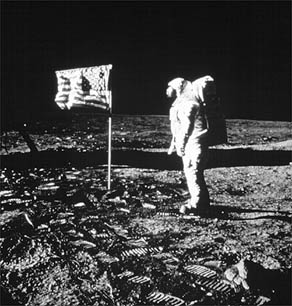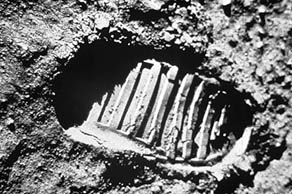New at the Planetarium

Follow the Drinking Gourd
During February, Black History Month, Buhl Planetarium presents
a true pre-Civil War story about slaves escaping to freedom in the north
by following the Big Dipper
In Carnegie Science Center's planetarium show Follow the Drinking Gourd
the "drinking gourd" signifies the Big Dipper, which slaves escaping from
plantations in the South before the Civil War followed northward to freedom
in journeys lasting as long as a year. The show is derived from a children's
book by Jeanette Winter which tells the story of a family of slaves that
escapes a plantation through the Underground Railroad. Based on actual
history, it tells of a sailor named Peg Leg Joe, a secret conductor on
the Underground Railroad, who traveled throughout the South singing a song
that cryptically gave slaves directions for escaping to the North.
How was it done? Slaves escaping to the North used the Big Dipper and
its relation to the North Star to orient themselves, while they followed
a long and difficult route to freedom, as many as 800 miles, much of it
on foot, from Mississippi to the Ohio River. The lyric "When the sun comes
back, and the first quail calls," refers to migrating quail which returned
in the springtime, when slaves typically began their journey. "The old
man is a-waiting," was a clue to look for the old sailor, Peg Leg Joe.
The "riverbank" in the second passage is the Tombigbee River which leads
north from the Gulf of Mexico to Tennessee. "Left foot, peg foot, traveling
on,"-refers to drawings of a peg leg and a foot-drawn on dead trees on
the trail so escaping slaves would know they were on the right path. "When
the great big river meets the little river" is the junction of the Tennessee
and Ohio rivers, where fugitive slaves could find guides who would take
them further north.
The show will be presented daily at 2:00 p.m. in February. After that,
the show will remain available through
the end of the school year for school groups. Call 237-3400 for more
information.
-Mark Petruzzini
When the sun comes back, and the first quail calls,
Follow the drinking gourd.
For the old man is a-waiting for to carry you to freedom
If you follow the drinking gourd.
The riverbank makes a very good road,
The dead trees will show you the way.
Left foot, peg foot, traveling on,
Follow the drinking gourd.
The river ends between two hills,
Follow the drinking gourd.
There's another river on the other side,
Follow the drinking gourd.
When the great big river meets the little river,
Follow the drinking gourd.
For the old man is a-waiting for to carry you to freedom
If you follow the drinking gourd.
 Flashback to the
Future Flashback to the
Future
Planetarium Show Celebrates Space Age Firsts
Travel through time and relive events that represent the Space Age during
the Henry Buhl, Jr. Planetarium's latest production Flashback to the Future,
40 Years of Space Exploration...and Counting, showing now through March
6.
 Audiences ride
along with the Soviet pioneers who made space history when they launched
Sputnik, a 23-inch metal sphere containing a radio beacon, on October 4,
1957. Elvis Presley was all the rage, Eisenhower was sending troops to
Little Rock and the Cold War was an ominous threat to world peace as this
first satellite orbited Earth. Few scientists believed the Soviets had
the sophisticated hardware to achieve such a technological marvel, but
their feat shocked the world and they continued to dominate the record
books for another 40 years. Audiences ride
along with the Soviet pioneers who made space history when they launched
Sputnik, a 23-inch metal sphere containing a radio beacon, on October 4,
1957. Elvis Presley was all the rage, Eisenhower was sending troops to
Little Rock and the Cold War was an ominous threat to world peace as this
first satellite orbited Earth. Few scientists believed the Soviets had
the sophisticated hardware to achieve such a technological marvel, but
their feat shocked the world and they continued to dominate the record
books for another 40 years.
All that changed on May 25, 1961, with President John F. Kennedy's "Address
to Congress on Urgent National Needs." This speech launched the space race
to the moon, culminating in Apollo 11's landing on the lunar surface July
16, 1969.
 Producer
James Hughes says the show is "not just a profile of hardware and launches,
but a unique representation of the events that changed our world and how
we look at the other worlds in our solar system." Indeed, Flashback to
the Future depicts the important cultural influence of the space program
on the world's population. Producer
James Hughes says the show is "not just a profile of hardware and launches,
but a unique representation of the events that changed our world and how
we look at the other worlds in our solar system." Indeed, Flashback to
the Future depicts the important cultural influence of the space program
on the world's population.
Sifting through hundreds of hours of NASA film footage, rarely seen
Russian launch sequences and the artifacts of popular culture, the program
lifts out highlights from the history of rocketry. Beginning back at the
dawn of humankind and flashing forward to a manned mission to Mars, a unique
multimedia experience awaits planetarium show audiences.
-Jen Sever, Carnegie Science Center
Test Your Knowledge Space "Firsts"
1. Who began space exploration in 1610 when he pointed a telescope to the
heavens?
2. Who was the American father of rocketry, who launched the first liquid-filled
rocket?
3. What was the name of the first satellite to orbit the Earth?
4. What was the Russian name of the first dog in space?
5. Who was the first human in space?
6. What year did the first space walk take place?
7. Name the first spacecraft to soft-land on the moon.
8. What planet was the first to be reached by a spacecraft from Earth?
9. Name the American spacecraft that made the first lunar landing.
10. Who was the first human to walk on the moon?
Click here for answers.
|
 Flashback to the
Future
Flashback to the
Future Audiences ride
along with the Soviet pioneers who made space history when they launched
Sputnik, a 23-inch metal sphere containing a radio beacon, on October 4,
1957. Elvis Presley was all the rage, Eisenhower was sending troops to
Little Rock and the Cold War was an ominous threat to world peace as this
first satellite orbited Earth. Few scientists believed the Soviets had
the sophisticated hardware to achieve such a technological marvel, but
their feat shocked the world and they continued to dominate the record
books for another 40 years.
Audiences ride
along with the Soviet pioneers who made space history when they launched
Sputnik, a 23-inch metal sphere containing a radio beacon, on October 4,
1957. Elvis Presley was all the rage, Eisenhower was sending troops to
Little Rock and the Cold War was an ominous threat to world peace as this
first satellite orbited Earth. Few scientists believed the Soviets had
the sophisticated hardware to achieve such a technological marvel, but
their feat shocked the world and they continued to dominate the record
books for another 40 years.
 Producer
James Hughes says the show is "not just a profile of hardware and launches,
but a unique representation of the events that changed our world and how
we look at the other worlds in our solar system." Indeed, Flashback to
the Future depicts the important cultural influence of the space program
on the world's population.
Producer
James Hughes says the show is "not just a profile of hardware and launches,
but a unique representation of the events that changed our world and how
we look at the other worlds in our solar system." Indeed, Flashback to
the Future depicts the important cultural influence of the space program
on the world's population.